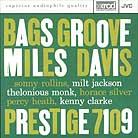February 1999
Of course, these CDs are more than just dates. If you want to know what Miles was up to in 1954, it’s here, hard bop being the currency of the day. Both Bags Groove and Walkin’ are considered part of Davis’ comeback from a sort of self-imposed obscurity -- too many low-key gigs, a tendancy he would revisit, among others, via the serenity on the Columbia recordings that would follow. The title tracks from both discs may be the headliners, but the other numbers, which are also shorter in duration, are what round out the collections and give them their legs. "Solar" from Walkin’ was written by Davis and shows him at his muted, understated best, while "Oleo" and "Doxy" from Bags Groove highlight Sonny Rollins’ whimsical writing (both tunes were penned by him) and playing as well as a bit of the leader's artistic benevolence. Bags Groove also includes alternate takes of the title tune as well as the Gershwin war-horse "But Not for Me." Both only enhance the overall package. The sound is typical JVC XRCD -- sweeter, smoother and even more resolved than the OK-sounding original issues, CD at its best. Both are recorded in mono, but it’s "big mono," a term XRCD producer Akira Taguchi used to describe recordings such as these. The images project so well and there’s so much air that mono isn't a disappointment. In fact, the absence of the hard-right and -left images of early stereo recording is a real asset. It’s as though the performers are wedge-shaped (bear with me here), expanding as the individual notes "appear" in the music and thus spread the center image. However one describes it, the result is very satisfying. I’ve now heard a handful of JVC’s XRCDs, and I can say that they don’t sound like other remasters, which are often considered triumphant if detail buried in the master tapes is unearthed. This applies to JVC discs -- they seemingly find nuance unheard before -- but they add a refined character that’s typical across the part of the catalog I’ve sampled. There’s really something to the XRCD process that makes the discs worth their premium price, and I can’t wait until we can A/B an XRCD and 24/96 recording of the same material. We may discover that attention to detail pays off even with CDs -- and 16/44.1 isn’t so awful after all. GO BACK TO: |
 Miles Davis & The Modern
Jazz Giants - Bags Groove
Miles Davis & The Modern
Jazz Giants - Bags Groove  Miles Davis All Stars - Walkin’
Miles Davis All Stars - Walkin’![[Reviewed on CD]](../format/regcd.gif) If
Miles Davis had a bad day in 1954, it wasn’t any of the four on which Bags Groove
and Walkin’ were recorded. And how could he with the musical dream team he
fronts on both recordings? Players include Sonny Rollins, Milt Jackson, Horace Silver,
Thelonious Monk and J.J. Johnson along with the rhythm section of Percy Heath and Kenny
Clarke. It’s obvious that the thing for a jazz man to do in 1954 was play with
Miles.
If
Miles Davis had a bad day in 1954, it wasn’t any of the four on which Bags Groove
and Walkin’ were recorded. And how could he with the musical dream team he
fronts on both recordings? Players include Sonny Rollins, Milt Jackson, Horace Silver,
Thelonious Monk and J.J. Johnson along with the rhythm section of Percy Heath and Kenny
Clarke. It’s obvious that the thing for a jazz man to do in 1954 was play with
Miles.